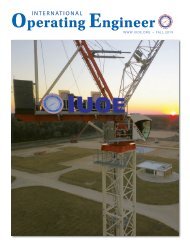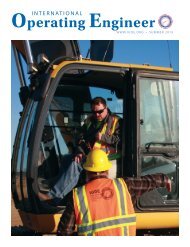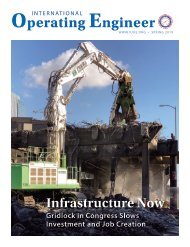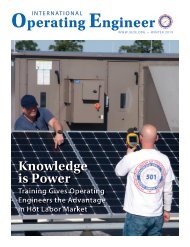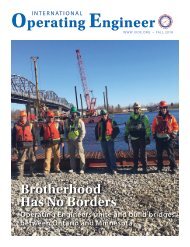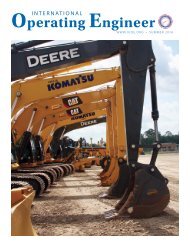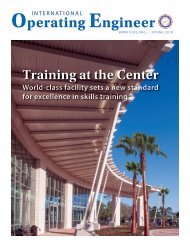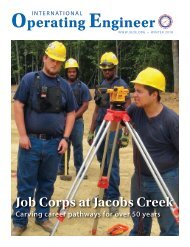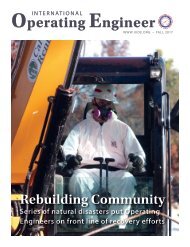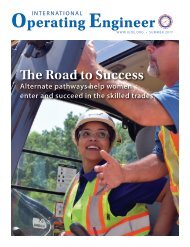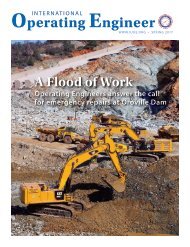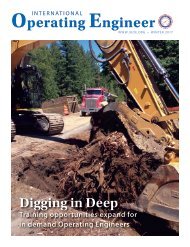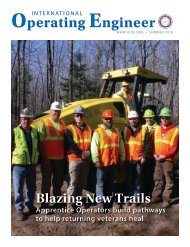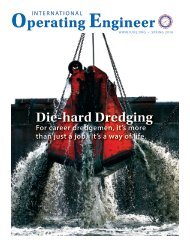125 Years Strong – An IUOE History
Celebrating the 125th Anniversary of the founding of the International Union of Operating Engineers
Celebrating the 125th Anniversary of the founding of the International Union of Operating Engineers
Create successful ePaper yourself
Turn your PDF publications into a flip-book with our unique Google optimized e-Paper software.
INTERNATIONAL UNION OF OPERATING ENGINEERS<br />
previous decade and ushered in a renaissance<br />
of sorts. Examining the union’s “primary years<br />
of renewed growth in 1991 and 1992,” Union<br />
Resilience in Troubled Times proclaims:<br />
“That combination of local<br />
initiative and Frank Hanley’s<br />
administrative acumen and<br />
aggressive organizational initiatives<br />
have been the primary causes of<br />
the union’s embryonic resurgence<br />
during the early 1990s.”<br />
<strong>An</strong> agreement signed February 24, 1994,<br />
between the A.F.L.-C.I.O Building and<br />
Construction Trades Department and the<br />
United Steelworkers of America (U.S.W.A.)<br />
to end a 15-year jurisdiction battle had<br />
particular significance to the I.U.O.E. After<br />
the steelworkers in 1980 unilaterally negated<br />
an agreement that had been negotiated in 1977<br />
to strictly limit activities of U.S.W.A. District<br />
50 in the construction industry, intrusions by<br />
the steelworkers had been a constant problem<br />
and undermined hard-won, long-established<br />
I.U.O.E. wages and benefits, costing its<br />
members jobs.<br />
Then in 1995, the union and General<br />
President Hanley identified another<br />
top priority: Construction Organizing<br />
Membership and Education Training<br />
(COMET). A two-step program to involve<br />
the rank-and-file membership in efforts to<br />
regain construction-market share by providing<br />
them with the fundamentals of organizing on<br />
jobsites, the union began to push all of its locals<br />
to participate in COMET.<br />
A Century of Skilled Craftsmen<br />
“One-hundred years of progress<br />
and advancement. One-hundred<br />
years of providing significant<br />
improvements in the work lives of<br />
its members. That, in essence, is<br />
the enviable history of simply the<br />
very best trade union in the United<br />
States and Canada ... or anywhere<br />
else. It is the history of our union:<br />
The I.U.O.E.”<br />
<strong>–</strong> I.U.O.E. General President Frank Hanley<br />
The International Operating Engineer,<br />
February-March 1996<br />
Members of I.U.O.E. Local No. 324 of Michigan place a piece of track<br />
during construction of the Detroit People Mover, a 2.94-mile elevated train<br />
encircling the city’s downtown area that was built from 1985 to July 1987.<br />
Among the jobsites on which members were<br />
working was the largest-ever public-works<br />
project in the United States, Boston’s “Big Dig”<br />
(formally the Central Artery/Tunnel Project),<br />
which rerouted the elevated central artery<br />
of Interstate-93 under the city’s downtown<br />
through a 1.5-mile tunnel; built two bridges<br />
totaling 14 lanes over the Charles River;<br />
and extended the highway to Logan Airport<br />
through the new, 1.6-mile Ted Williams Tunnel<br />
under Boston Harbor. Started in 1992, the job<br />
employed more than 900 operating engineers<br />
from a dozen different I.U.O.E. locals, with<br />
the majority from Boston’s Local No. 4, who<br />
operated more than 150 cranes of various types<br />
and sizes before it was completed in 2007.<br />
By the end of 1993, the I.U.O.E. had<br />
emerged from a difficult period in its history<br />
and was in a stronger position. Its net worth<br />
had almost doubled between 1987 and 1992<br />
from $44.4 million $83.6 million, its three<br />
pension plans were in solid financial condition<br />
and the cooperative relationship between the<br />
international and its locals was never better. (2)<br />
The programs and other efforts undertaken<br />
by the union in the early 1990s essentially<br />
put an end to the decline it experienced the<br />
Members of I.U.O.E. Local No. 3, which has jurisdiction over California, Hawaii, Nevada and Utah, take a<br />
break on one of the dirt spreads in 1987 during work on the California Department of Transportation’s<br />
Redwood National Park Bypass project through the Eureka area in Northern California.<br />
LABOR OMNIA VINCIT<br />
WORK CONQUERS ALL



